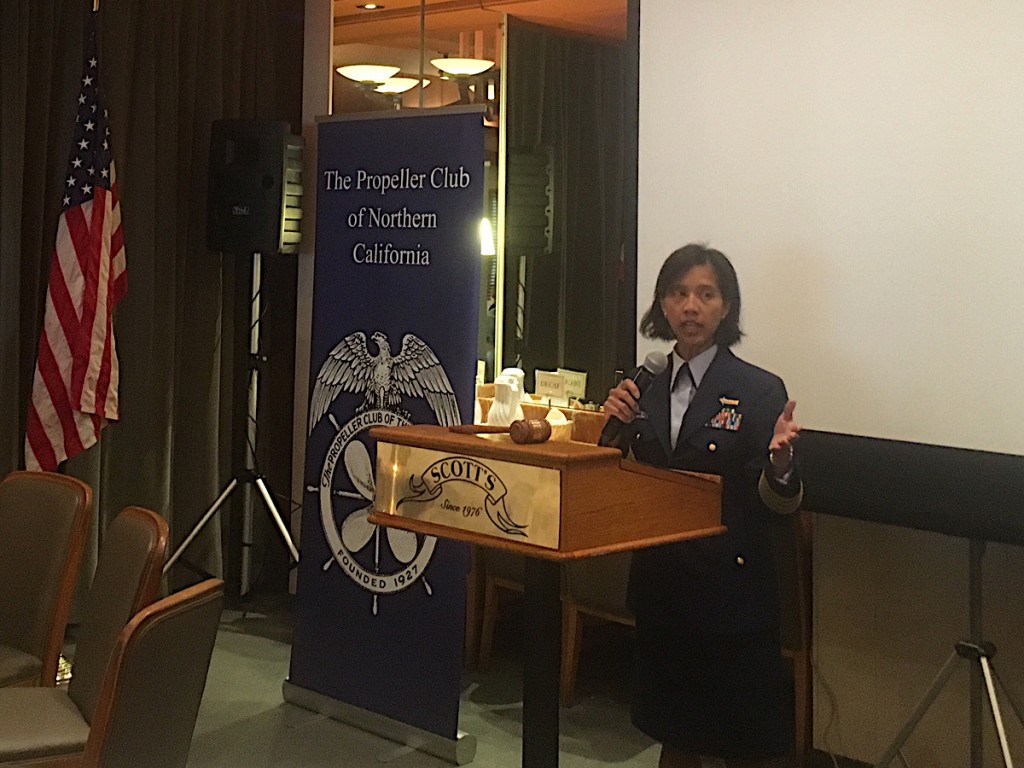US Coast Guard’s Byrd urges emergency preparedness citing bridges & refineries
U.S. Coast Guard Captain Marie Byrd told attendees at the Propeller Club of Northern California on September 10th that vulnerabilities of bridges and refineries continue to be a focus of emergency response plans seeking to protect the Marine Transportation System (MTS).
Byrd said emergency response exercises focusing on the San Francisco Bay Area Port Recovery Plan will be part of the annual Fleet Week San Francisco activities taking place between October 6-14, 2019.
Port partners include the Ports of Oakland, San Francisco and Redwood City.
Captain Byrd assumed command of U.S. Coast Guard Sector San Francisco in March 2019 and serves as the Sector Commander and Captain of the Port for San Francisco and Northern California. She leads over 850 Active and Reserve Coast Guardsmen operating four Cutters, seven Search and Rescue Stations, an Aids to Navigation Team, a Vessel Traffic Service, and a Marine Safety Detachment.
Byrd said the exercises are part of a broader plan to prepare for an earthquake, cyber-attack or other catastrophic event that could impact the MTS and Northern California ports.
Captain Byrd noted that the San Francisco Bay is very reliant on its bridge system for commuters, trucking and freight rail: “The bridges play a critical transportation role and the Coast Guard is working closely together with other stakeholders to respond quickly to an emergency.”
Byrd noted that the Coast Guard works closely with the Water Emergency Transportation Authority (WETA) to plan for deployment of its commuter ferry fleet to transport commuters and emergency personnel in the event that one or more bridges in the Bay Area are damaged.

WETA carries over three million passengers annually utilizing a fleet of 14 high speed passenger-only ferry vessels. It currently serves the cities of Alameda, Oakland, Richmond, San Francisco, South San Francisco and Vallejo.
Byrd also noted that the Coast Guard works closely with the Harbor Safety Committee, coordinated by the Marine Exchange of the San Francisco Bay.
Captain Byrd noted that a malfunction at the Rio Vista Bridge, a drawbridge, had blocked shipping on the Sacramento River linking the Port of Sacramento. She cited this as an example of the vulnerability that bridges face in an earthquake or other catastrophic event: “The Port of Sacramento is a major exporter of agricultural goods and the interruption of vessel service hurts shipments including commodities such as rice. If there were a second malfunction of the Union-Pacific Railroad Bridge, this would impact agricultural exports emanating from the Port of Stockton as well.”
The Union Pacific Railroad's Benicia-Martinez drawbridge located at the Carquinez Strait was built between 1928 and 1930 to allow railway traffic to cross Suisun Bay. It is the access point for shipping headed to and from the ports of Sacramento and Stockton. The drawbridge’s horizontal clearance is 291 feet and vertical clearances are 70 feet (closed) and 135 feet (open).
Captain Byrd noted that there are five petroleum refineries in the Bay Area and that they provide critical fuel supplies for the entire US Pacific Coast and for the Southwest: “If the Marine Transportation System was damaged or out of commission in the San Francisco Bay, there would be a three to four-week delay in resupply from other petroleum sources.”
The California Energy Commission notes that over 700,000 barrels per day of oil are refined by Chevron, Marathon, Shell, Valero and Philips 66. Statewide, California refines around 2 million barrels of oil per day.
© Copyright 1999–2024 American Journal of Transportation. All Rights Reserved

